The Dorich House Burglary
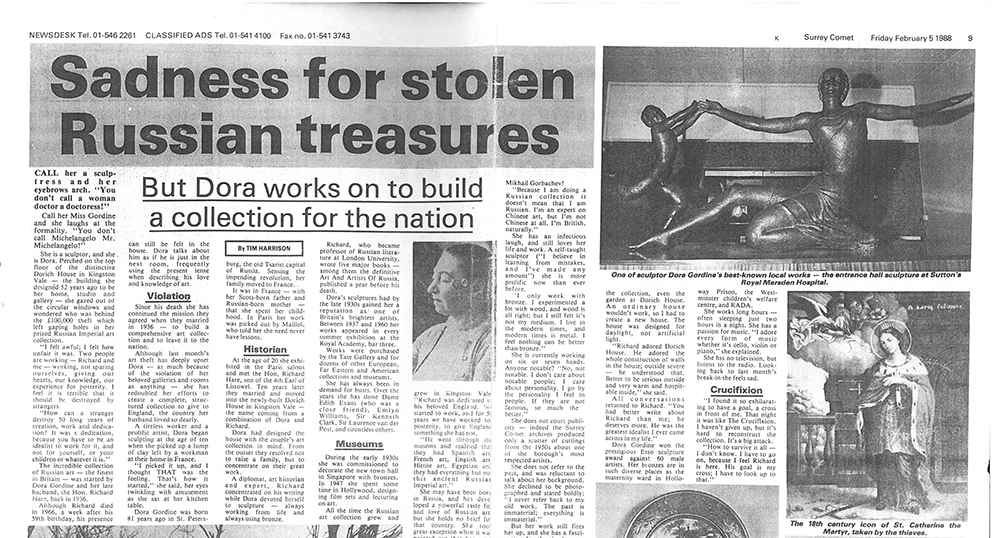
1988 saw a major burglary of Russian art at Dorich House. But what was actually stolen and was anything recovered? Here volunteer Carley Bucknell uses all available evidence to explore this pivotal moment in the history of Dorich House and the legacy of Dora Gordine and Richard Hare.
‘A frugal sleeper, she was sitting in her living room when the men marched in. They shone a torch in her eyes and told her that she wouldn’t be hurt if she remained silent.’[1]
– Tim Harrison, The Surrey Comet, 5 February 1988
The early hours of 21 January 1988 were devastating for Dora Gordine. Newspaper articles state that she was alone in her house and, after a peaceful evening reading in her living room where she had fallen asleep,[2] she was awoken by a stranger holding a torch in her eyes while his accomplice ransacked her home, Dorich House.[3] The burglars reportedly took over £100,000[4] worth of mainly Russian Imperial art and artefacts, which Gordine had been collecting for over 50 years, starting the collection in the 1930s with her late husband Richard Hare.[5] The couple had planned to leave their collection of artefacts to become a museum for the nation; the roughly 100 objects that were stolen that night were therefore not just a loss to Gordine, but to the couple’s legacy as well.[6] And it is because of the emotional impact of the burglary on Gordine, who was then in her early nineties, that, in my opinion, we can understand the importance of this story to the history of Gordine and Dorich House.
I have been a volunteer on and off at Dorich House for the last four years and the burglary has always been a fascination to me. I often wondered what was stolen, when and how it happened, and what, if anything, was recovered. While it is unlikely we will ever have all the answers, I was eager to use the opportunity presented by The Squatter Years project to investigate this topic, in the hope of uncovering some answers to my burning questions. I hope to pursue a career in art crime and provenance, so this topic felt particularly relevant to me and I find the process of research and uncovering facts valuable. For this research, I have accessed a variety of sources to try and piece together the story of the burglary, including newspaper reports, interviews, a New Scotland Yard inventory of burgled items, museum archive documents, and auction catalogues. Although I have been able to glean a significant amount of information about the theft, much of it is complex and unclear and, in some cases, the accounts contradict each other. So, throughout my research, I have attempted to remain open to all accounts and reports.
As often seen with thefts, many theories were formulated at the time as to what had happened to the stolen items and, although some objects were recovered (including several items now in the Dorich House Museum collection, such as the figurine Lady with a Dog), much is still missing to this day. At the time of the theft, there was purportedly an active black market for Russian artefacts in Germany, so some journalists speculated that the objects may have gone there and that this was the reason why many were never found.[7] Tim Harrison, a journalist from The Surrey Comet who became a close friend of Gordine’s after interviewing her about the burglary, also suggested in a recent oral-history interview that Scotland Yard had become involved in the case because they believed it had been orchestrated by Russian thieves,[8] who perhaps anticipated finding a market for them in Russia. In his Surrey Comet article from 5 February 1988, Harrison wrote that the thieves were careful not to leave any fingerprints and were selective in what they took, which led the police to suspect that the theft was premeditated and that the men were either experts in Russian art or had been given a ‘shopping list’ from experts who hired them.[9] Gordine had begun opening her home in the late 1980s to show members of the public the Russian art collection and her own sculptures.[10] Therefore, it seems possible that the author/s of such a ‘shopping list’ had been on one of these tours. However, according to Harrison, some of the targeted rooms were not included in the tours (most likely the private flat on the top floor).[11] Many of the stolen items were illustrated in Hare’s book The Art and Artists of Russia (1965), so it is also possible that this book provided the burglars with a means of selecting items, although the book does not identify items as belonging specifically to Gordine and Hare. I think it is also likely that, although the burglars may have come in with a list of items, they left with extra pieces, both from the book and not, which might explain why objects were taken from the flat and also why the thieves stayed for two-and-a-half hours, which seems to me unusually long for a premeditated burglary.[12]
‘How to survive it all – I don’t know, I have to go on…’[13]
– Gordine, in an interview with the Tate Gallery, 27 June 1990
The finer details of the burglary differ quite a lot in the various sources, but I have found enough to form what feels like a fairly accurate account of the theft. The intruders left at around 3am, but, according to one source, it was another three to five hours before Gordine was able to get in touch with the police because the burglars had disconnected the telephone line.[14] Moreover, by Gordine’s own account, her eyesight was affected for two days after from having had the torch shone in her eyes.[15] Entries in the visitor book that Gordine kept show that security services attended the house the day after the burglary – adding cameras and various other measures to prevent another invasion – which also suggests the potential emotional impact the experience had had on the elderly sculptor.[16] In a recent interview, Harrison discussed how vulnerable Gordine felt living alone, especially after the burglary, so much so that she did not let anyone new visit without an escort: it really ‘took the wind from her sails’.[17]
‘I found it so exhilarating to have a goal, a cross in front of me. That night it was like “The Crucifixion”. I haven’t given up, but it’s hard to reconstruct the collection. It’s a big attack.’[18]
– Gordine interviewed in The Surrey Comet, 5 February 1988
Unfortunately, according to newspaper articles and auction records only a small portion of the stolen artefacts were recovered and returned home to Dorich House. One newspaper article suggests that the head detective on the case, Detective Sergeant Ray Bloxham CID, seemed to believe the loot had been divided into ‘more manageable groups’ ready for distribution abroad.[19] In the months following the burglary, newspapers reported the return of at least two of these groups. The first, reported by Harrison in The Surrey Comet, was a collection of Russian icons stripped of their frames, which were found hidden in the bottom part of a wardrobe in a Chelsea hotel room on the Old Brompton Road.[20] The police had been prompted to search the room after receiving an ‘underworld tip-off’ that a wanted man was there. Strangely, no connection seemed to be made between this wanted man and the burglary itself. He had already fled the hotel room when the police arrived, but at least seven of the Dorich House icons were found.[21] Another discovery, reported by Sue Bradley in the Kingston Informer, was found in April, three months after the burglary took place. Two paintings were allegedly recovered in the left luggage section at Victoria Station where detectives believed they ‘could have been dumped or been awaiting collection’.[22] The first recovered painting was a seventeenth-century copy of Francesco Barbieri, known as Il Guernico’s painting The Mystic Marriage of St Catherine. The second was not given a title; it was instead described as a ‘19th century Russian religious painting’. This painting intrigued me as the report also said, ‘Although this painting is not the most valuable it is of particular significance to Mrs Hare’.[23] I became determined to find out what this painting could be.
Research into this painting yielded many contradictory, confusing and complex results that led to many uncertain answers. One thought was that this could be the painting described by Bradley in her original article on the burglary in the Kingston Informer from 29 January, as the ‘19th century “Coronation of the Virgin”’. She described it as ‘approximately 2ft square – and still in its frame’.[24] When searching the Phillips auction catalogues from the mid-1990s (when objects from Dorich House were sold to defray the costs of renovation following Gordine’s death in 1991), I found a painting with the same title listed for sale on 25 October 1994 (unfortunately unillustrated). Although the catalogue stated that this painting was smaller than the one Bradley had described and not square,[25] I do not feel that this is enough to disregard the possibility that it was the same painting, although it does add certain doubt. Nonetheless, finding it in the auction catalogue intrigued me as it suggested the painting was recovered. The auction catalogue stated that the painting was made by a ‘Follower of Dionys Calvaert (Antwerp 1540–1619 Bologna)’. Initially I found very little on this artist, but then discovered that over his career he was known under various names, including ‘Denys Calvaert’. Using the new name, I discovered a print of a Coronation of the Virgin composition by Calvaert made by the printmaker Domenico Tibaldi in 1573, held by the British Museum.[26]
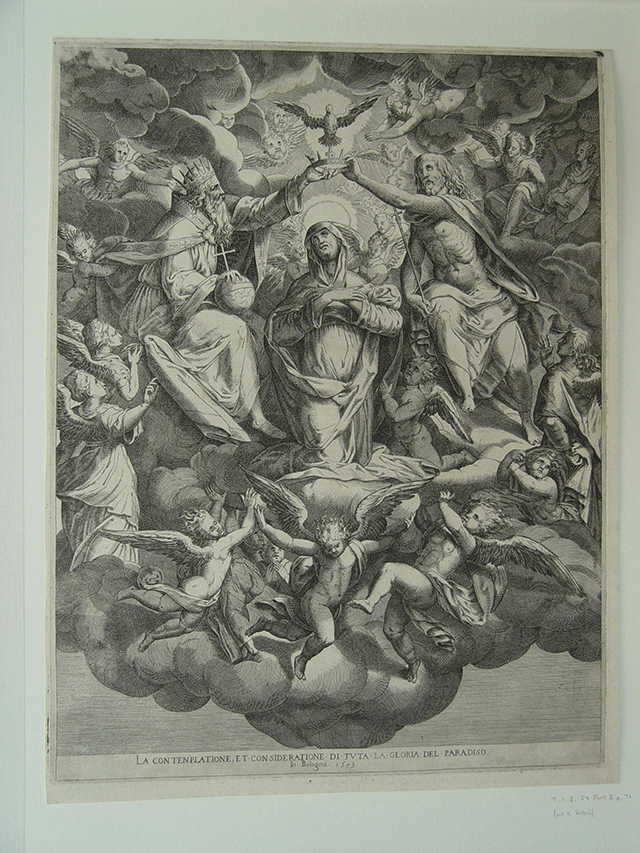
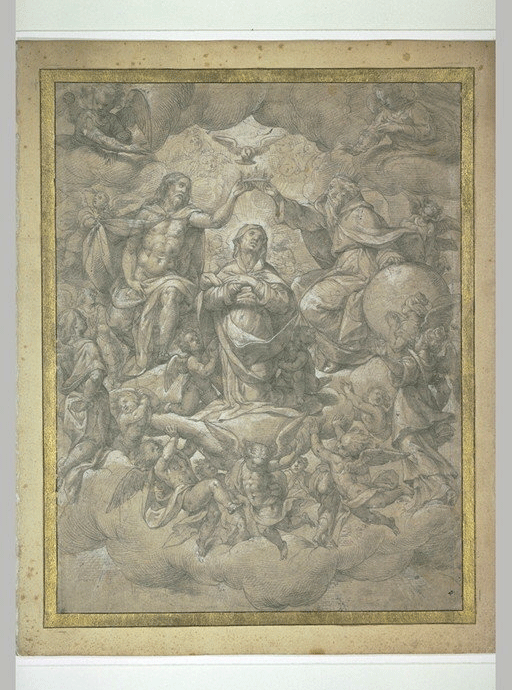
This then led me to an original sixteenth-century black chalk drawing by Calvaert, held in the Louvre’s collection, from which the Dorich House painted copy could have been made.[27] However, could this be the ‘19th century Russian religious painting’ described in the April Kingston Informer article? Not only are there doubts because of the reported size, questions also arose for me because the original drawing was sixteenth century and the artist was Flemish. Moreover, when Bradley discusses this ‘19th century Russian religious painting’ she states that it was ‘not the most valuable’,[28] but her report from 29 January declares The Coronation of the Virgin to be one of the most valuable paintings in the collection.[29] This implies that The Coronation of the Virgin and the ‘19th century Russian religious painting’ are not the same.
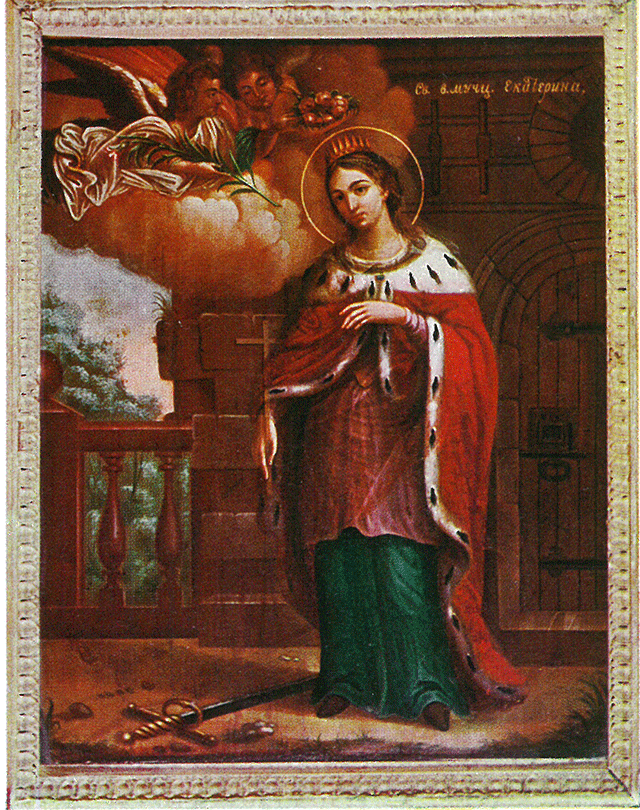
Instead, could this recovered work be another religious painting that we know to have been stolen and recovered? The Russian icon St Catherine the Martyr is a unique late eighteenth-century or early nineteenth-century painting which, unlike most depictions, portrays the saint without the famous breaking wheel. This icon was perhaps more important to Gordine than The Coronation of the Virgin as the New Scotland Yard inventory lists it specifically and it had also been illustrated in Hare’s book The Art and Artists of Russia. As the New Scotland Yard list was probably made from a dictation by Gordine, it seems likely a piece of ‘particular significance’ to her would be specified to the police. This suggests that the second piece mentioned by Bradley as recovered at Victoria Station could be St Catherine the Martyr. However, this painting was also specifically mentioned by Harrison as one of the seven icons recovered from a Chelsea hotel room.[30] As a painting cannot be recovered twice, either Harrison was incorrect or the ‘19th century Russian religious painting’ was in fact The Coronation of the Virgin or an entirely different piece. The research, especially for The Coronation of the Virgin, was complicated. There were often dead ends and I was unable to find anything definitive. Nevertheless, even though the search came to nothing concrete, it was an interesting and enjoyable piece of research.
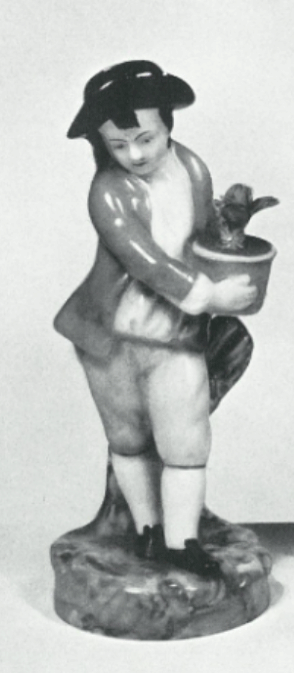
Amongst the stolen objects were also at least 26 Russian porcelain figurines, made by the Popov, Kornilov and Gardner factories.[31] These stolen figurines were listed in the New Scotland Yard inventory and were of traditional Russian themes, including the Dairymaid and Wandering Pilgrim. I found in my research that they also included subjects that appear to be rarer such as a Dandy and Girl in Blue Trousers Leaning on a Beer-barrel. While some figurines were recovered, others such as a Boy Carrying a Potted Plant were not. Like many of Gordine’s porcelain figurines, this one was made by the Gardner Factory, a Russian porcelain-maker founded by an Englishman in 1766. Boy Carrying a Potted Plant was described as Gordine’s favourite piece in one newspaper article.[32] If that is true, it must have been one of the biggest losses she felt from the burglary. In the New Scotland Yard inventory, the figurine is listed as having been placed in a hanging cabinet in the dining room, welcoming her guests into her private flat, which in my opinion shows how personal it was to her. Through my research I found other editions of this figure that have been sold at auction in the last few years. While it is unlikely we will know if one of these is Gordine’s, it has given me more insight into the object.[33] Boy Carrying a Potted Plant was not the rarest object in her collection, but it is the bond with Gordine that makes it a heart-breaking loss.
The magic of art is its ability to connect with one emotionally. Collections are often not based around financial benefits, but on the bonds between object and owner. Gordine and Hare both loved Russian artefacts and it is from this love that the collection was created. In the years I have volunteered at Dorich House Museum, I have seen the Russian collection as the tie that bound them together, the force that made their relationship one I have always admired. The collection, after Hare’s death in 1966, seemed to become Gordine’s way of memorialising not only their marriage but her husband too. By taking these objects, the burglars seemed to steal that memory from her. ‘I felt awful’, she said in an interview with journalist Tim Harrison:
‘I felt how unfair it was. Two people are working – Richard and me – working, not sparing ourselves, giving our hearts, our knowledge, our experience for posterity. I feel it is terrible that it should be destroyed by strangers.’[34]
Since the 1911 theft of the Mona Lisa from the Louvre, art thefts have often been sensationalised in the media as though they are dramatic films, often forgetting the emotional losses that come along with them. However, for the 1988 Dorich House burglary, these news stories have enabled me to recognise the emotional, as well as financial, loss to Gordine, a remarkable sculptor and woman, who had part of her and her husband’s legacy robbed by such a terrible event.
Carley Bucknell
Published as part of the project The Squatter Years: Recovering Dorich House Museum’s Recent Past, funded by the National Lottery Heritage Fund, January 2021.
[1] Tim Harrison, ‘Sadness for Stolen Russian Treasures: But Dora Works on to Build a Collection for the Nation’, The Surrey Comet, 5 February 1988.
[2] Sue Bradley, ‘Treasure Hunt’, Kingston Informer, 5 February 1988.
[3] Harrison, ‘Sadness for Stolen Russian Treasures’, 5 February 1988.
[4] While the figure of £100,000 was most commonly cited, other figures such as ‘millions of pounds’ (Standard Reporter, ‘Millions in Art Treasures Stolen’, News Standard,, 21 January 1988) and ‘£40,000’ (‘Famous Artist Found Dead’, unidentified newspaper clipping, 3 January 1992).
[5] Harrison, ‘Sadness for Stolen Russian Treasures’, 5 February 1988.
[6] Number surmised from an inventory of burgled contents made by the New Scotland Yard Police Antiques Investigation Branch, 1988.
[7] Harrison, ‘Sadness for Stolen Russian Treasures’, 5 February 1988.
[8] Tim Harrison, oral-history interview by Mengfei Liu, December 2020, Dorich House Museum archive.
[9] Harrison, ‘Sadness for Stolen Russian Treasures’, 5 February 1988 and Bradley, ‘Treasure Hunt’, 5 February 1988.
[10] Bradley, ‘Treasure Hunt’, 5 February 1988.
[11] Harrison, ‘Sadness for Stolen Russian Treasures’, 5 February 1988.
[12] Dora Gordine, interview by David Fraser Jenkins and Derek Pullen from the Tate Gallery, 27 June 1990, Dorich House Museum archive. Other reports suggest that the theft only lasted an hour (Sue Bradley, ‘Thieves Used “Shopping List”: Works of Art Still Missing’, Kingston Informer, 29 January 1988).
[13] Gordine, interview by Jenkins and Pullen, Tate, 27 June 1990.
[14] Harrison, ‘Sadness for Stolen Russian Treasures’, 5 February 1988.
[15] Harrison, ‘Sadness for Stolen Russian Treasures’, 5 February 1988.
[16] Dorich House Visitor Book, 1988, Dorich House Museum archive.
[17] Harrison, interview by Liu, December 2020.
[18] Harrison, ‘Sadness for Stolen Russian Treasures’, 5 February 1988.
[19] Tim Harrison, ‘Icons Found from Underworld Tip’, The Surrey Comet, [no date].
[20] Harrison, interview by Liu, December 2020 and Harrison, ‘Icons Found from Underworld Tip’, [no date].
[21] Harrison, ‘Icons Found from Underworld Tip’, [no date].
[22] Sue Bradley, ‘Police Led to Stolen Treasures’, Kingston Informer, 29 April 1988.
[23] Bradley, ‘Police Led to Stolen Treasures’, 29 April 1988.
[24] Bradley, ‘Thieves Used “Shopping List”’, 29 January 1988.
[25] The auction catalogue states that the sold painting was ‘12in. x 9in. (30.5cm. x 22.8cm.)’ (Fine Old Master Paintings and Picture Frames, Phillips London, 25 October 1994, lot 79).
[26] Domenico Tibaldi, after Denys Calvaert, The Coronation of the Virgin Surrounded by Angels, engraving, 1573, British Museum, London, https://www.britishmuseum.org/collection/object/P_1874-0613-588.
[27] Dionys Calvaert, Le Couronnement de la Vierge [The Coronation of the Virgin], black chalk heightened on grey paper, sixteenth century, Louvre, Paris, http://arts-graphiques.louvre.fr/detail/oeuvres/10/201548-Le-Couronnement-de-la-Vierge.
[28] Bradley, ‘Police Led to Stolen Treasures’, 29 April 1988.
[29] Bradley, ‘Thieves Used “Shopping List”’, 29 January 1988. In fact, The Coronation of the Virgin onlysold for £300 at auction in 1994.
[30] Harrison, ‘Icons Found from Underworld Tip’, [no date].
[31] Inventory, New Scotland Yard Police Antiques Investigation Branch, 1988.
[32] Harrison, ‘Sadness for Stolen Russian Treasures’, 5 February 1988.
[33] Other editions of this figurine are listed here: ‘A Porcelain Figure of a Boy-Gardener’, Russian Art, Christie’s, London, 8 November 2016, lot 291, https://www.christies.com/lotfinder/Lot/a-porcelain-figure-of-a-boy-gardener-by-6039621-details.aspx; and with another figurine listed as ‘Two Porcelain Figurines of a Flower Girl and Boy’, An Important Collection of Porcelain Figurines. Private Russian Manufactories, MacDougall’s, London, 25 March 2015, lot 15, https://docplayer.net/45259592-Russian-art-an-important-collection-of-porcelain-figurines-private-russian-manufactories-macdougall-s-russian-art-25-march-2015-london.html.
[34] Harrison, ‘Sadness for Stolen Russian Treasures’, 5 February 1988.

